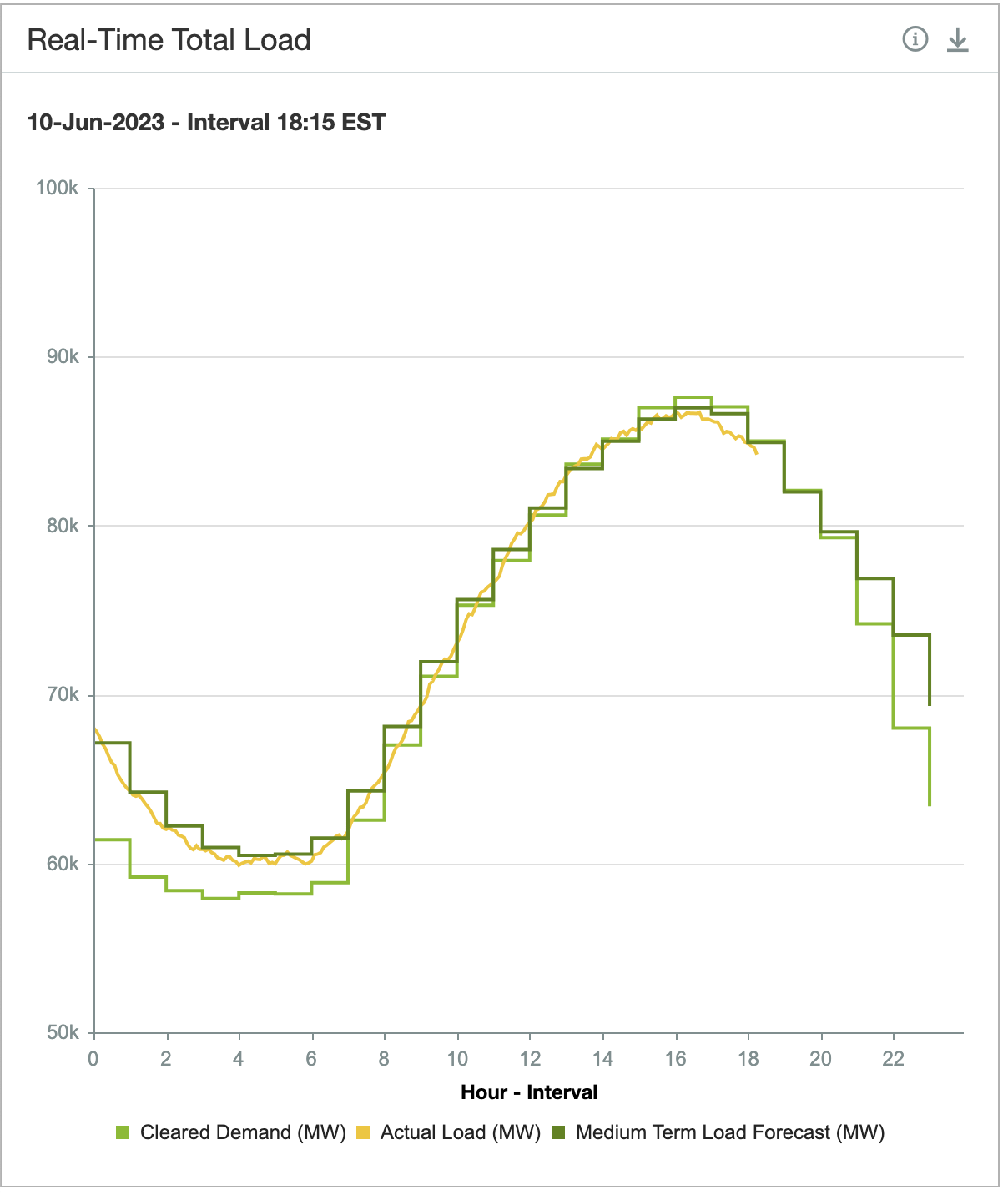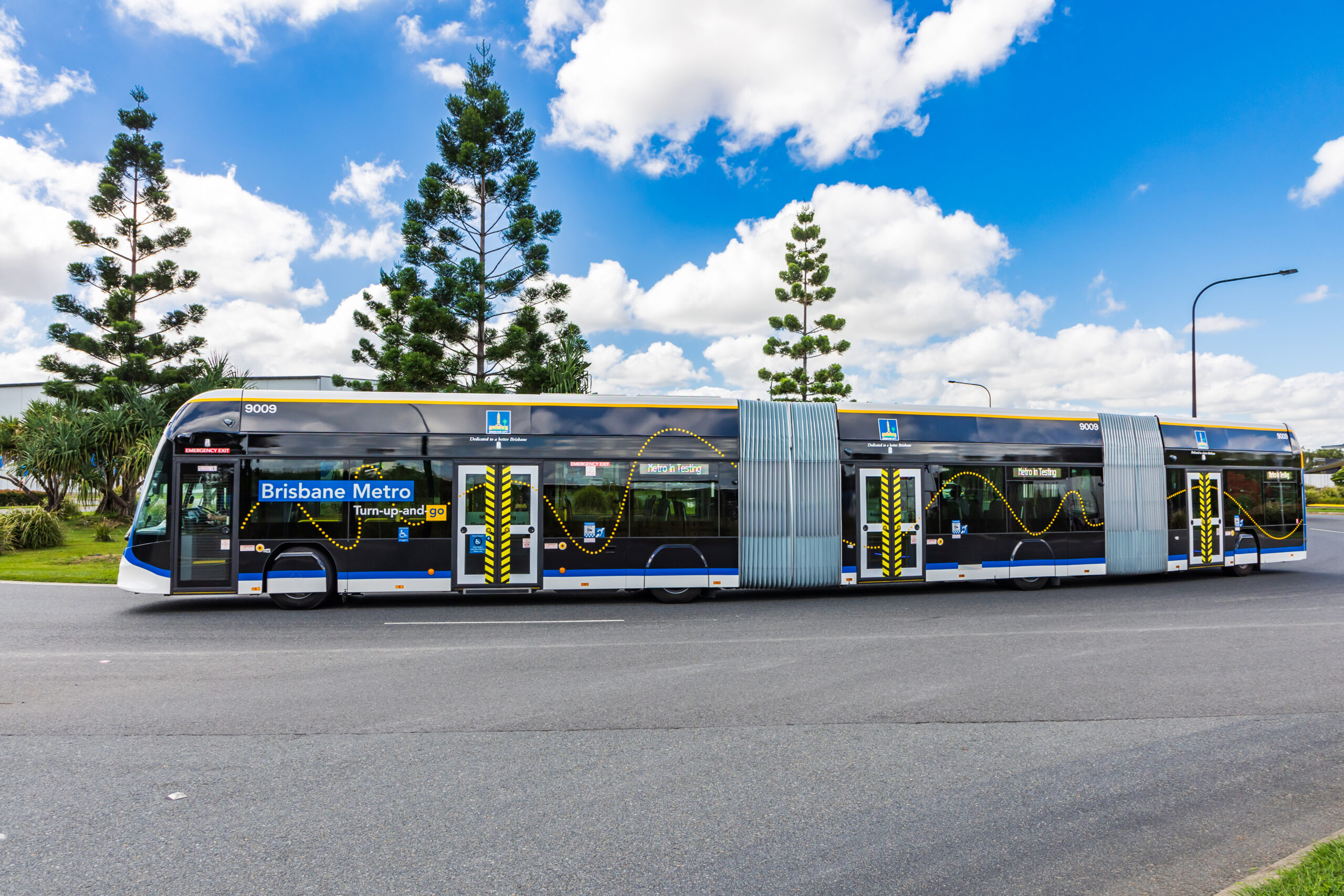
Part 1 of this series outlined the total increase in grid capacity needed for a 100% electrified light duty vehicle (LDV) fleet in the US by 2040. It showed that with no additional technology, the required grid capacity increase is on the low end of historic grid growth. This part will cover a set of mature technologies that exploit the nature of battery electric energy storage to solve the twin issues of continuously balancing electric grid generation with demand and the intermittency of wind and solar power.
We start with the basic fact that, to avoid outages, every grid is designed to output the highest peak power during the hottest hour of the year. At other times, some power plants are turned down or off and under-utilized. The chart below illustrates this for MISO (the Midcontinent Independent System Operator), which operates the grid here in the Midwest. In these data, the average over the off-peak hours of midnight to 7:00 AM was 71% of the peak load for the day, and 49% of the all-time peak of 127 GW. This and a lot more real-time data on grid demand can be found on the company’s website. What this represents is an opportunity to use grid resources more efficiently by deploying loads that can be dispatched; that is, controlled to only draw power when there is extra capacity.
As it happens, all current electric vehicles support automatic off-peak charging where the owner can set the time to start and end charging that matches the utility’s off-peak period. In most areas, a 100% EV fleet could charge overnight with no additional power generators. Since utilities are able to use the same grid resources to sell more power, they gain financially. Most offer lower off-peak rates (time of use or TOU), making EV charging even cheaper for drivers. Investor-owned monopoly utilities are typically required to pass along cost savings to ratepayers (customers), so all customers win with the higher grid resource utilization that comes with dispatchable loads like electric vehicles.
Grid Capacity & Load Balancing
Grid load balancing refers to the process of managing and distributing the electrical load on the power grid to ensure that electricity supply matches demand in real-time. It involves adjusting generation and consumption to maintain grid stability, prevent blackouts, and optimize the utilization of available resources. Electric vehicles can perform many of the key functions needed for grid load balancing and stability.
- Demand Response: EVs can participate in demand response programs, where they adjust their charging or discharging patterns in response to grid conditions. When renewable energy generation is high and the grid has excess capacity, EVs can be charged to utilize the surplus electricity. Conversely, during periods of high electricity demand or low renewable energy generation, EVs can reduce their charging or discharge their stored energy to support the grid.
- Vehicle-to-Grid (V2G) Technology: EVs equipped with V2G technology can not only draw power from the grid but also return electricity back to it. During periods of high electricity demand, EVs can discharge power to the grid, acting as distributed energy resources. This bidirectional flow of energy helps balance the grid by providing additional electricity when needed, thus stabilizing fluctuations in supply and demand.
- Grid Storage: EVs, collectively, represent a large distributed energy storage resource. By intelligently managing the charging and discharging of EV batteries, the grid can effectively utilize this storage capacity. During times of high renewable energy generation, excess electricity can be stored in EV batteries, reducing curtailment of renewable energy sources. When renewable generation is low, the stored energy in EVs can be utilized to meet demand, reducing the need for fossil fuel-based power generation.
- Grid Frequency Regulation: EVs can provide grid frequency regulation services. By adjusting the charging or discharging rate of EVs in response to changes in grid frequency, they can help maintain a stable frequency within acceptable limits. This is particularly valuable when integrating intermittent renewable energy sources, which can cause frequency fluctuations. EVs can act as a flexible load or source of power to help balance the frequency.
- Load Shifting: EVs offer the ability to shift electricity demand from peak to off-peak periods. By encouraging off-peak charging of EVs through time-of-use pricing or incentives, the grid can better utilize renewable energy resources, which often have higher generation during off-peak hours. Load shifting helps balance the grid by reducing demand during peak periods and optimizing the integration of renewable energy into the grid.
- Local Grid Support: In areas with limited grid infrastructure, EVs can provide localized support. For instance, during power outages or emergencies, EVs can supply electricity to critical infrastructure or act as mobile power sources. This capability enhances grid resilience and reduces dependency on centralized power generation and distribution.
By leveraging the capabilities of EVs, the grid can better accommodate the variability and intermittency of renewable energy sources. This enables a larger percentage of renewable electricity generation while maintaining grid stability, reducing carbon emissions, and fostering a more sustainable energy system.
Achieving a 100% EV scenario will be a gradual process, allowing time for necessary infrastructure upgrades and adjustments to be made. Collaboration between governments, utilities, and private entities will be essential in ensuring a smooth transition to an EV-dominant transportation system while maintaining a reliable and resilient electric grid.
This post originally appeared on Let’s Go Zero Carbon.
Sign up for daily news updates from CleanTechnica on email. Or follow us on Google News!
Have a tip for CleanTechnica, want to advertise, or want to suggest a guest for our CleanTech Talk podcast? Contact us here.
Former Tesla Battery Expert Leading Lyten Into New Lithium-Sulfur Battery Era — Podcast:
I don’t like paywalls. You don’t like paywalls. Who likes paywalls? Here at CleanTechnica, we implemented a limited paywall for a while, but it always felt wrong — and it was always tough to decide what we should put behind there. In theory, your most exclusive and best content goes behind a paywall. But then fewer people read it! We just don’t like paywalls, and so we’ve decided to ditch ours. Unfortunately, the media business is still a tough, cut-throat business with tiny margins. It’s a never-ending Olympic challenge to stay above water or even perhaps — gasp — grow. So …





